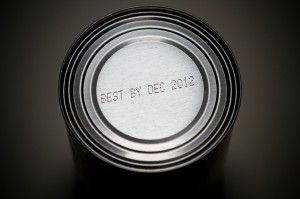 This past September, 22-year-old university student Solveiga Pakštaité won the James Dyson Award for a final class project. She invented a brand new take on expiry labels that has the potential to change the date system we’ve been using until now. Not only is this product unique because virtually anyone can touch it to find out if their food has expired, but it’s also much more accurate than a traditional printed expiry date. Not convinced? Continue reading to learn all about Bump Mark!
This past September, 22-year-old university student Solveiga Pakštaité won the James Dyson Award for a final class project. She invented a brand new take on expiry labels that has the potential to change the date system we’ve been using until now. Not only is this product unique because virtually anyone can touch it to find out if their food has expired, but it’s also much more accurate than a traditional printed expiry date. Not convinced? Continue reading to learn all about Bump Mark!
A Multilayered Solution
If you are currently enrolled in a food quality training program, you will definitely be interested in understanding just how Bump Mark is made. The product is a small triangular label that is designed to be stuck onto food packaging immediately after the food has been packaged. It contains four different layers, which include two sheets of plastic film, filled with one bumpy sheet of plastic, covered by a layer of gelatine.
If it Feels Bumpy, Throw it Away
Gelatine is a substance that reacts to environmental factors (temperature, oxygen, sunlight, etc.) just the way fresh food does. Someone who has had food safety training can understand that because gelatine is similar to most food in this way, placing a Bump Mark label on food packaging will allow the gelatine to decay along with the product. When your food is fresh, the gelatine will remain solid and the label will feel smooth. But as your food begins to decompose, the gelatine follows suit and transforms into a liquid state. This will create a bumpy feeling – an indicator that the food has expired and must be thrown away. If you are thinking of pursuing HACCP certification, this is a product you might want to keep tabs on, as it has the capacity to prevent the mistaken consumption of food that’s past its prime.
Inspiration Behind the Project
Solveiga Pakštaité originally designed Bump Mark with a specific consumer in mind – the visually impaired. Because the printed expiration labels that we currently use are not very useful to visually impaired people, the ability to feel if their food has expired would be tremendously helpful.
No Tech Required
Something about this product that might be shocking to many people, is that it requires no technology to function. These days, news such as this is quite exciting because technology-free products generally have lower price points. Says Solveiga Pakštaité in a recent interview: “Some [electronic-based solutions] cost at best 2p a label, which is very expensive. Bump Mark doesn’t contain any electronics, so it’s going to be far more low-cost.”
When Will We See Bump Mark On Our Food?
Pakštaité has been receiving a lot of requests from companies that are interested in implementing her design. Just one month ago in November, she performed a trial with Asda, a British-based, American owned grocery store chain – however, no results have been released yet. It looks as though if all goes well with this test run, we can expect to see Bump Mark on our food packages sometime in 2015.
What do you think? Would you trust Bump Mark over a conventional expiration date?



